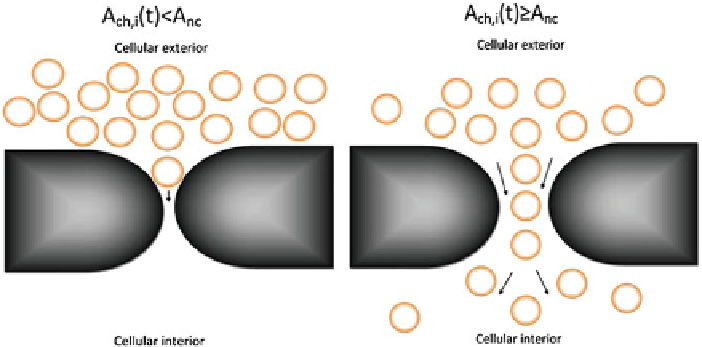Biomedical Engineering Reference
In-Depth Information
Fig. 6.12
Nanoparticles that avoid moving through the membrane's hydrophobic core cannot move
through a pore/channel with a non-hydrophobic core under the condition
A
ch
,
i
A
nc
(see the
left panel
). Under this condition, no matter how high the nanoparticle concentration in the cellular
exterior region might be, there would be no presence of nanoparticles in the cellular interior region.
Any nanoparticle shows a finite probability to move through the same pore/channel under the
condition
A
ch
,
i
(
t
)<
A
nc
. In this case, depending on a nanoparticle concentration in the cellular
exterior region, there is a possibility to find a finite number of nanoparticles in the cellular interior
region (see the
right panel
). The nanoparticle migration may also be influenced by many other
physiological membrane properties like such as gradients of pressure or electrical potentials across
the cell membrane
(
t
)
≥
N
p
tot
(
t
)
=
i
=
1
p
i
(
t
)
(6.10)
As a first-order approximation, one can use the Gaussian form for
A
ch
,
i
(
t
)
,
2
(exp
), but to obtain a better fit with the triangular nature of the single
conductance event (see Fig.
6.10
) one needs to use the following form for
A
ch
,
i
(
(
−
α(
t
−
t
0
)
)
t
)
t
0
|
β
)
A
ch
,
i
(
t
)
∼
exp
(α
|
t
−
(6.11)
where
α
∼
2. The value of
β
should be calculated from a good fit
to the experimental data (see Fig.
6.10
). Here,
τ
is the lifetime of the conductance
event and
t
0
is the initial time. The form of
A
ch
,
i
(
1
/τ
and
β <
is never unique, and must
follow any function that fits with the pattern of a conductance event induced by an
agent such as the chemotherapy drugs or other agents that are proven to be better
candidates for a combination therapy to ensure improved transport of nanoparticles
through the membrane.
E
np
,
i
follows from a very complicated formulation using
both analytical and computational considerations equivalent to that explained in
to parameterize the energetics involved in nanoparticle-lipid interactions. Thus, an
actual order of values for
p
tot
(
t
)
t
)
regarding any specific nanoparticle can be derived.

Search WWH ::

Custom Search